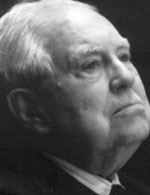|
|
Elliot Carter
Gavin Thomas introduces the work of Elliot Carter (1908–).
Overview
Elliott Carter belongs to that great line of American musical pioneers,
stretching from Charles Ives to
Conlon Nancarrow, whose radical works have
done so much to turn the old world of European
classical music on its head.
Like his early mentor
Ives, Carter’s music evokes a very American sense of place, both
the wide-open horizons of its deserts and plains, and the dense
cityscapes of its great metropolises, whose relentless energy and colliding narratives have
done so much to shape – subliminally at least – Carter’s
rich and dynamic style.
Tough and challenging it certainly is, but at its finest
Carter’s music has a cyclonic sweep and complexity which few other composers of
the past century have been able to match.
Carter came late to composition, despite early encouragement from Charles Ives,
who sold insurance to Carter’s parents until they discovered
the subversive influence he was exercising on their son.
Carter first studied English and mathematics at Harvard before, in
the face of determined parental opposition, going to Paris
to study with the celebrated teacher and Stravinsky disciple Nadia Boulanger.
Returning to America, Carter began to compose works combining elements
of Boulanger’s Neoclassicism (a style he later characterized,
following the advent of World War II, as “a masquerade in a bomb shelter”) with
a more populist American voice, as in his Symphony no.1 (1942) and Holiday Overture
(1944), though the gung-ho, Copland-esque idiom of these
pieces soon gave way to works of increasing originality.
The complex rhythmic structures of the 1946 Piano Sonata
– “like jazz improvisation, with the beat left out”, as Wilfrid
Mellors has described it – already push
the populist Neoclassical style to its limits, while the
Cello Sonata of 1948 goes still further, exploring the contrasting personalities
of the cello and piano, the first effusively emotional (representing
psychological time), the second percussive and admonitory (representing chronometric time) –
a perfect first example of the type of musical character drama
that was to form one of the bases of Carter’s mature work.
Still dissatisfied, however, Carter retired to the solitude
of the Arizona desert to work on his String Quartet No. 1 (1951),
the work which signalled his final coming of age.
Reflecting something of the grand wilderness amidst which it
was composed, the quartet’s heroic scale and exhilarating sweep
create a sense (as do so many of Carter’s subsequent works) of a
musical world in constant and majestic evolution,
as the work’s intersecting narratives move in and out of focus.
Shortly after its composition, the quartet won a major European prize,
propelling Carter to international prominence – paradoxically, as he wrote
it entirely for his own satisfaction, doubting it would ever be played.
Encouraged by the success of the quartet, over the next
two decades Carter launched into a series of increasingly innovative
works.
The theatrical String Quartet no. 2 (1959) further explored the
Cello Sonata’s technique of dramatically opposed and interacting
instrumental characters, while a sequence of three concertos – the
Double Concerto for Piano and Harpsichord (1961), the Piano Concerto (1965)
and the Concerto for Orchestra (1969) – raised the first quartet’s
principle of multi-layered musical narrative to heights
of ever greater complexity.
His quartet cycle continued in 1971 with his formidable String Quartet No. 3
which, with the Symphony for Three Orchestras (1976), marks
the outer limits of his strenuous technical experiments.
In 1975, the appearance of A Mirror on which to Dwell,
Carter’s first vocal work for thirty years, ushered in a new
period of creative ease.
The works, which had previously been few in number and
Herculean in effect, suddenly began to pour forth.
Further vocal works followed, along with two more string
quartets, a sequence of concertos for oboe (1987), violin (1990) and clarinet (1997); and
a constant stream of other works both large and small including, most
notably, Symphonia, Carter’s summatory orchestral work –
so far, at least. At the age of 89, he went so far
as to undertake his first opera, What Next?, the latest
and by no means final twist in one of musical history’s most remarkable Indian summers.
Article and review pages originally published in The Rough Guide
to Classical Music
|